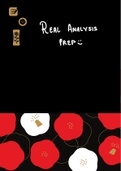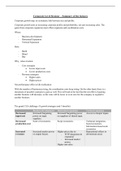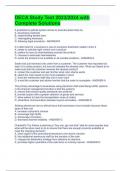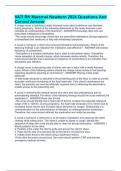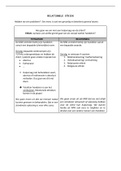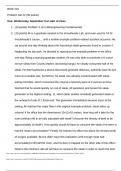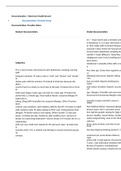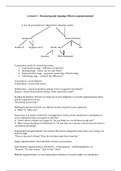REAL ANALYSIS
PREP
, THE WELL-ORDERING PRINCIPLE
the well sanderling principle
AXIOM 2 [ THE WELL -
ORDERING PRINCIPLE ] :
Every non -
empty subset of 1N has a smallest element .
THEOREM 3 [ THE PRINCIPLE OF MATHEMATICAL INDUCTION ] :
For each K C- IN
,
let PCKI be a
logical proposition concerning
the number K ( Pllc) is true / false
depending
the value of K) If Pll ) is true and for each C- IN there of that
on . n
,
is some
way showing
Pln ) true that Plnti ) Therefore PCKI true for all
being implies is true .
is KEN .
THEOREM : 2 is not a rational number
Proof [ proof contradiction ]
: if 52 is rational by
↳ : .
52 =
Pig pig C- Z
↳ Assume 9 C- IN
q > 0 : .
↳ : 52 is rational → s= {q c- IN : Eq C- Z } ≠ ∅
↳ has smallest element [ Well
s a
Ordering ] go .
↳ : 1 ( 2 [ 4 i. I < T2 ( 2
↳ Oc S2 -
I Ll
↳ 9 , =
152-1190
i. 0C 91 (
go
↳ But
go C- S
,
so 5290 C- Z
i.
9 5290 C- Z
go
-
, =
↳ But 0cg , 91 be C- IN and
cqo i. must 91<90
↳ However : 5291 =
5215290 -90 ] 290-5290 = .
!
9, C- S
↳ Contradicts go is the smallest element of 5
NUMBER SYSTEMS
IN -
natural numbers { 1,2 , 3,4 ,
. . . }
Z -
the
integers { . . .
, -3 , -2 , -1
, 0,112,3 }
④
-
rational numbers { mln : MEZ in C- IN }
IR real numbers { }
-
-
x.ro
Algebraically ,
it is difficult to
distinguish R and 02 . Thus we need another axiom .
Natural numbers
↳ Every subset has a smallest element CW-0.PT
↳ Natural lm.nl
separated
"
numbers are
" :
Mtn =) ≥ I
↳
They are bounded below : n so for all n C- IN
A subset ,
A ≤ IR is bounded below it there exists an M C- IR sit .
m≤ x for all ✗ C- A
i. We call m a lower bound for A.
lower bound
↳
Any
"
than
"
number smaller M is also a .
,THE COMPLETENESS AXIOM OF IR
THE COMPLETENESS AXIOM Ii
Any non -
empty subset
of IR that is bounded below has a
greatest lower bound .
To be the lower bound for A must
greatest a set
, a number m
satisfy two conditions :
① m ≤ x for all sc C- A
② For each number n with men ,
there is an x EA with x Cn .
THE COMPLETENESS AXIOM 2 :
of that above has least
Any non -
empty subset IR is bounded a
upper bound .
A c- IR is bounded above it there exists a number m such that x ≤ m for all ✗ C- A .
We call M for
an
upper bound A.
It A is bounded above → -
A = § -
x KEA } is bounded below
, .
Greatest lower bound = infimum
least upper bound supremum
=
MAXIMUM AND SUPREMUM
Maximum [ definition] We b the maximum of the set A it
say
: :
is
① for C- A a ≤ b
every a
,
② b C- A
→ Max IA ) =
maximum of A
Supremum [ definition] We that b is the least bound of A it :
say
:
•
upper
① for C- A a ≤ b
every a ,
② whenever a ≤ c for every a C- A
,
then b ≤ C.
→ sup (A) supremum of A
=
.
* A set need not have a maximum . [ even it it is bounded above]
* A set which is bounded above
always has a
supremum .
* It Max (A) exists , Max / A) C- A , sap (A) does not need to be an element of A .
* It above : 1A )
Max / A) exists
,
A is bounded SUPIA ) = Max
MINIMUM t INFIMUM
Minimum [ definition] We b the of the set A it
say
: :
is minimum
① for C- A a ≥ b
every a
,
② b C- A
→ mail.AT =
maximum of A
b the of it
Infimum [ definition] we that is
greatest lower bound A :
say
:
① for C- A a ≥ b
every a ,
② whenever a
≥ c for every a C- A
,
then b ≥ c.
infimum (A)
'
→ = int
* A set need not have a minimum [ even it it is bounded below ]
A has
* set which is bounded below always a infimum
* It Min / A) exists , min (A) C- A int CA ) does not need to be an element of A
,
.
* It min / A) exists
,
A is bounded above : int (A) = min .LA )
, BOUNDED SUBSETS
A subset A of IR is
bounded it it is bounded both above and below .
A is bounded iff .
there is a number B such that :
1×1<13 for all x C- A
Example : 1- =
{ sin ≥ : KEIR } where B=I
CONSEQUENCES OF THE
COMPLETENESS AXIOM
THE EXISTENCE OF TE
let A = { x c- IR : x2 C2 }
↳ A- =/ ☒ since 0 C- A
__ 2
y
- - - - - -
y
-
- -
1
I
:
• •
A
42
Claim : The number 2 is bound for A
an
upper
Proof : ① Consider number 0C with >2
any
a
i. x2 > 2x 74 Thus x & A
,
② The Completeness Axiom tells us that A has a least
upper bound ,
S .
that 0 's ≤ 2 and
such
sup (A) 2
=
<
Claim ; s =
52
Proof first
:
① Suppose that SZCZ
② For h 20 , Csth / 2 =
S2 tzsh th
?
any
③ It 0 < hcl ,
then hzch ,
so Csthl ? L S2 1- 4h th [ 5=2 ]
i. Csth )2 ( S2 1- 5h
④ By choosing h
sufficiently small
, we can make s2 1- 5h 22
But then 5th C- A :S isn't an
upper bound for A
PREP
, THE WELL-ORDERING PRINCIPLE
the well sanderling principle
AXIOM 2 [ THE WELL -
ORDERING PRINCIPLE ] :
Every non -
empty subset of 1N has a smallest element .
THEOREM 3 [ THE PRINCIPLE OF MATHEMATICAL INDUCTION ] :
For each K C- IN
,
let PCKI be a
logical proposition concerning
the number K ( Pllc) is true / false
depending
the value of K) If Pll ) is true and for each C- IN there of that
on . n
,
is some
way showing
Pln ) true that Plnti ) Therefore PCKI true for all
being implies is true .
is KEN .
THEOREM : 2 is not a rational number
Proof [ proof contradiction ]
: if 52 is rational by
↳ : .
52 =
Pig pig C- Z
↳ Assume 9 C- IN
q > 0 : .
↳ : 52 is rational → s= {q c- IN : Eq C- Z } ≠ ∅
↳ has smallest element [ Well
s a
Ordering ] go .
↳ : 1 ( 2 [ 4 i. I < T2 ( 2
↳ Oc S2 -
I Ll
↳ 9 , =
152-1190
i. 0C 91 (
go
↳ But
go C- S
,
so 5290 C- Z
i.
9 5290 C- Z
go
-
, =
↳ But 0cg , 91 be C- IN and
cqo i. must 91<90
↳ However : 5291 =
5215290 -90 ] 290-5290 = .
!
9, C- S
↳ Contradicts go is the smallest element of 5
NUMBER SYSTEMS
IN -
natural numbers { 1,2 , 3,4 ,
. . . }
Z -
the
integers { . . .
, -3 , -2 , -1
, 0,112,3 }
④
-
rational numbers { mln : MEZ in C- IN }
IR real numbers { }
-
-
x.ro
Algebraically ,
it is difficult to
distinguish R and 02 . Thus we need another axiom .
Natural numbers
↳ Every subset has a smallest element CW-0.PT
↳ Natural lm.nl
separated
"
numbers are
" :
Mtn =) ≥ I
↳
They are bounded below : n so for all n C- IN
A subset ,
A ≤ IR is bounded below it there exists an M C- IR sit .
m≤ x for all ✗ C- A
i. We call m a lower bound for A.
lower bound
↳
Any
"
than
"
number smaller M is also a .
,THE COMPLETENESS AXIOM OF IR
THE COMPLETENESS AXIOM Ii
Any non -
empty subset
of IR that is bounded below has a
greatest lower bound .
To be the lower bound for A must
greatest a set
, a number m
satisfy two conditions :
① m ≤ x for all sc C- A
② For each number n with men ,
there is an x EA with x Cn .
THE COMPLETENESS AXIOM 2 :
of that above has least
Any non -
empty subset IR is bounded a
upper bound .
A c- IR is bounded above it there exists a number m such that x ≤ m for all ✗ C- A .
We call M for
an
upper bound A.
It A is bounded above → -
A = § -
x KEA } is bounded below
, .
Greatest lower bound = infimum
least upper bound supremum
=
MAXIMUM AND SUPREMUM
Maximum [ definition] We b the maximum of the set A it
say
: :
is
① for C- A a ≤ b
every a
,
② b C- A
→ Max IA ) =
maximum of A
Supremum [ definition] We that b is the least bound of A it :
say
:
•
upper
① for C- A a ≤ b
every a ,
② whenever a ≤ c for every a C- A
,
then b ≤ C.
→ sup (A) supremum of A
=
.
* A set need not have a maximum . [ even it it is bounded above]
* A set which is bounded above
always has a
supremum .
* It Max (A) exists , Max / A) C- A , sap (A) does not need to be an element of A .
* It above : 1A )
Max / A) exists
,
A is bounded SUPIA ) = Max
MINIMUM t INFIMUM
Minimum [ definition] We b the of the set A it
say
: :
is minimum
① for C- A a ≥ b
every a
,
② b C- A
→ mail.AT =
maximum of A
b the of it
Infimum [ definition] we that is
greatest lower bound A :
say
:
① for C- A a ≥ b
every a ,
② whenever a
≥ c for every a C- A
,
then b ≥ c.
infimum (A)
'
→ = int
* A set need not have a minimum [ even it it is bounded below ]
A has
* set which is bounded below always a infimum
* It Min / A) exists , min (A) C- A int CA ) does not need to be an element of A
,
.
* It min / A) exists
,
A is bounded above : int (A) = min .LA )
, BOUNDED SUBSETS
A subset A of IR is
bounded it it is bounded both above and below .
A is bounded iff .
there is a number B such that :
1×1<13 for all x C- A
Example : 1- =
{ sin ≥ : KEIR } where B=I
CONSEQUENCES OF THE
COMPLETENESS AXIOM
THE EXISTENCE OF TE
let A = { x c- IR : x2 C2 }
↳ A- =/ ☒ since 0 C- A
__ 2
y
- - - - - -
y
-
- -
1
I
:
• •
A
42
Claim : The number 2 is bound for A
an
upper
Proof : ① Consider number 0C with >2
any
a
i. x2 > 2x 74 Thus x & A
,
② The Completeness Axiom tells us that A has a least
upper bound ,
S .
that 0 's ≤ 2 and
such
sup (A) 2
=
<
Claim ; s =
52
Proof first
:
① Suppose that SZCZ
② For h 20 , Csth / 2 =
S2 tzsh th
?
any
③ It 0 < hcl ,
then hzch ,
so Csthl ? L S2 1- 4h th [ 5=2 ]
i. Csth )2 ( S2 1- 5h
④ By choosing h
sufficiently small
, we can make s2 1- 5h 22
But then 5th C- A :S isn't an
upper bound for A

